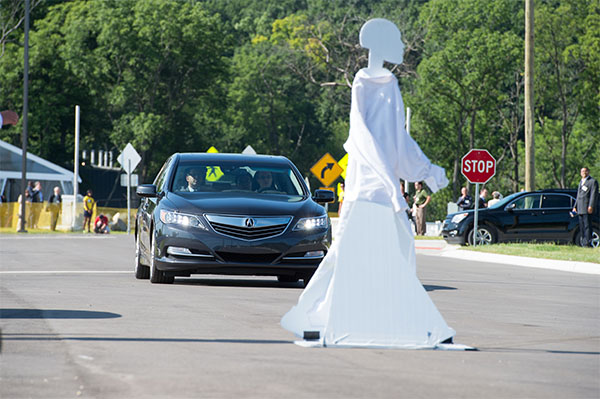
Power-split hybrid powertrains, in which planetary gears connect the engine and motors, have been gaining in popularity in hybrid-electric vehicles (HEVs) in recent years, and for good reason. Power-split designs enable multi-mode operations, and their high efficiency and compact size also contribute to the appeal.
“Multi-mode, power-split hybrids are the future of HEVs,” said Huei Peng, Roger L. McCarthy Professor of Mechanical Engineering and U-M MCity Director. “They make it possible to completely change the nature of the power train by switching among multiple operating modes and as a result are much more flexible in the trade-off between fuel economy and drivability.”
But searching the design space for new and optimal HEV designs and proper component sizing yields an unwieldy number of possibilities.
Peng and his research group have developed an automated modeling methodology that searches designs to identify the optimal configuration and component size for a power-split system.
In contrast to the conventional approach, the Peng team methodology systematically searched through all possible designs, sometimes hundreds of millions of them, to identify dozens of potential designs. In simulations, the designs offered significant improvements over both launching performance and fuel economy, when compared with two popular HEVs currently in production and using identical powertrain components including the engine, battery and motors.
The industry has taken notice and several companies, including Bosch, have supported Peng’s research to apply their methodology to the design of an all-wheel drive hybrid vehicle, as well as a two-wheel-drive Class-4 truck.
The research team searched relevant designs and vetted them for both design attributes, such as all-wheel regenerative braking, and performance attributes, including launch acceleration, towing capacity and speed range. Next, the team whittled the list of possible designs based on fuel efficiency.
In simulations, Peng’s group demonstrated the world’s first four-wheel drive, multi-mode, power-split HEV. Their configuration uses two output shafts from the transmission, offering improved performance, independent torque control, and optimal fuel efficiency. Clutches between the two planetary gears enable multiple operating modes.
The approach can be applied to other hybrid vehicle designs and, Peng believes, help grow HEV adoption.
“There are very few hybrid sport utility vehicles (SUVs) or light trucks (LTs) on the U.S. market today, even though SUVs/LTs now make up more than 60 percent of light-duty vehicle sales. All-wheel drive is going to be a key enabler of HEV adoption, giving buyers more options,” he said.
Driving safer automated vehicles
 Nearly every OEM and several technology companies are developing automated vehicle concepts. Testing those concepts is a critical step to ensuring safety, but the testing process can take a long time, in part due to the statistical rarity of crashes – about one fatality per 100 million vehicle miles traveled, according to the National Highway Traffic Safety Administration.
Nearly every OEM and several technology companies are developing automated vehicle concepts. Testing those concepts is a critical step to ensuring safety, but the testing process can take a long time, in part due to the statistical rarity of crashes – about one fatality per 100 million vehicle miles traveled, according to the National Highway Traffic Safety Administration.
“To reach an 80 percent confidence level that automated vehicles are 90 percent safer than we humans are, test vehicles would have to be driven for more than 10 billion miles” said Peng, who directs Mcity, U-M’s autonomous and connected vehicle test facility. “We need a methodology that cuts out the non-eventful parts of driving in order to accelerate the process.”
Existing automated vehicle evaluation methods include field tests and Monte Carlo simulations, neither of which enables the investigator, statistically, to bypass the many miles driven without incident to get to the events of interest.
Peng and former graduate student Ding Zhao, who earned his PhD in 2016 and now serves as an assistant research scientist in the ME department, have developed a methodology that does, known as accelerated evaluation.
Peng draws an analogy to the testing of materials. “Engineers expose materials to acidity, high temperature, or high moisture, for example, to accelerate corrosion tests. Instead of humidity or acidity, we’re looking at the aggressive moves of other drivers and cars, such as cutting off the automated vehicle during a lane change,” he explained. “In statistical terms, we’re using importance sampling rather than uniform sampling.”
The accelerated evaluation methodology includes naturalistic driving data from over 25 million miles traveled, new models and simulations of challenging situations and aggressive moves of human drivers in other vehicles, and statistical insights into realistic benefits and risks.
The methodology sped the testing process by between 300 and 100,000 times, two to four orders of magnitude. Plans are in place to implement accelerated evaluation at Mcity in the coming months.
“We’re planning to have a robotic vehicle that implements the new statistics,” Peng said, “and we’ll make sure that the autonomous vehicles tested here are challenged by our aggressive robotic driver, so that the validation test is done in shorter time and at much lower cost.”
